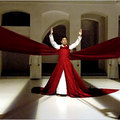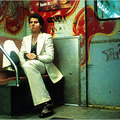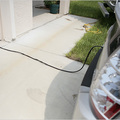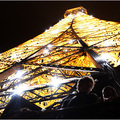IT'S deer season in Luxembourg. You'll find blue, yes blue, deer all over the capital city of the world's only grand duchy — on brochures, on banners and as four-foot-high metal sculptures. The deer, with 2007 stamped on its hindquarters, is the symbol of Luxembourg's year as the cultural capital of Europe.
This deer is worth stalking — an endeavor that will become much more convenient in June, when new TGV train service from Paris will cut the journey from nearly four hours to just over two. Culture hunters will find a new I. M. Pei-designed modern art museum (now with a retrospective of the works of the Luxembourg-born Michel Majerus), a two-year-old concert hall and a pair of recently opened exhibition spaces that were once railroad round-houses.
Luxembourg's National History and Art Museum is a glorious space, renovated in 2002, and its History of the City Museum completed the reinstallation of its permanent collection in February. Within the last few years, a 14th-century hospice was turned into the dynamic Natural History Museum, and the old Benedictine Neumünster Abbey is now a cultural center. A Fortress Museum will open this summer showcasing the city's military architecture.
That's particularly appropriate since Luxembourg is a fortress, with a deep river valley surrounding the old city on three sides. From a castle built on its rocky promontory in 963, the strategic settlement grew, passed between Burgundian, French, Spanish, Austrian and Prussian hands. Each conqueror strengthened the natural site, until at one point the defenses included three fortified rings, 24 forts, a 14-mile network of underground tunnels and more than 400,000 square feet of chambers carved into the sandstone for soldiers, animals and supplies. Even though a peace treaty in 1867 decreed that this “Gibraltar of the North” be destroyed, you can still see plenty of intriguing remains: the old town and the fortress walls constitute a Unesco World Heritage site. You can explore the casements from March to October.
In summer the official residence of the grand duke (Henri, who turns 52 tomorrow) is open to the public. But you can see his Renaissance palace, and the single soldier who stands guard in front of it, by following one of the tourist office's walking tour brochures. There's a Wenzel Walk — named for Wenceslas II (not the one of Christmas fame), duke from 1383 to 1419 — which runs along the ancient fortifications from the old city plateau down into the Grund district below (an elevator will bring you back). And there's a guide to the European quarter, home to the General Secretariat of the European Parliament and the European Court of Justice, among other institutions that make Luxembourg a destination for Eurocrats.
What does all this have to do with blue deer? At the tourist office on Place Guillaume, which dates from the 13th century, Luc Wies explained: “Migration is the theme for the European Capital of Culture 2007, and the deer is common to the entire region.” Mr. Wies repeated what nearly every local will tell you: Luxembourg is a small place (about 475,000 people, 100 square miles). And unlike many parts of Europe, it actually welcomes immigrants. Over 60 percent of the city's population is not from Luxembourg, and more than 120,000 commute to work from across the border. In fact, the Capital of Culture designation is for “Luxembourg and the Greater Region,” extending into parts of neighboring Belgium, France and Germany. “The deer doesn't stick to any boundaries,” Mr. Wies said. “It just goes wherever it likes.”
Luxembourg draws its share of loyal visitors. “This is our fourth or fifth visit to Luxembourg,” said Bill Rothe, a businessman from California, who was visiting in January. “I think it is one of the quaintest, cleanest, most representative cities in Europe.” And relatively unexplored. “How many Americans come here?” he asked. “They don't even know it's a country.”
Marita Ruiter, an Austrian who owns Galerie Clairefontaine, picks up the small-place refrain. “We don't have the artistic networks, the established collectors or the media,” she said. “But still things are better here than ever before.”
The turning point was 1995, Luxembourg's first year as the European cultural capital (it's the only city to hold the designation twice). That is when the Casino Luxembourg, a 19th-century gambling and cultural center (Franz Liszt played there in 1886) was transformed into a contemporary art forum. (Through June 17, it will be devoted to 100 provocative videos, from the likes of Chen Chieh-jen and Sam Taylor-Wood.)
Luxembourg does exude a certain small-town warmth. Monique Kieffer, director of the National Library, came into Ms. Ruiter's gallery one afternoon to say hello, while Roland Schauls, a Luxembourg artist, was in the process of transferring his show from there to another location — a bank (Luxembourg, a popular tax haven, has about 150 of them). Mr. Schauls is internationally known for “Portrait Society,” his versions of 504 self-portraits from the Uffizi in Florence, which dominates the glass-covered courtyard of Neumünster Abbey.
Another benefit of being small: Luxembourg can claim more Michelin-starred restaurants per capita than any other country. At the one-star Clairefontaine, Arnaud Magnier is making a name for himself with such dishes as “surprise scallops” (cooked in their spring-loaded shells, which pop open when they are served). And Luxembourgers are talking about the young chef Yves Radelet, who turns out classics like beef Rossini as well as inventive fare like fish with Asian spices. And he makes all his own cheeses.
“Its hard to get a bad Italian meal here,” said Mary Carey, a Canadian journalist who has lived in Luxembourg for 17 years. Her favorite is Il Fragolino, a modest pasta-and-pizza place in the Grund district. The Michelin inspectors prefer Mosconi, also in Grund, bestowing two stars on it. The sleek, popular (especially with British expatriates) Lagura Next Door offers both Italian dishes (risotto with fresh white truffles was a recent daily special) and a “world food” menu, from Iberian ham to Thai curry. For earthy local cuisine, judd mat gaardebounen (smoked pork with broad beans) and chicken cooked in riesling are on offer at the wood-paneled Maison des Brasseurs.
If your definition of culture extends to night life, little Luxembourg lives large. In the old town, the smart set drinks 15-euro coupes de Champagne and dances to '70s and '80s classics at the VIP Room and White, side-by-side on the Rue des Bains, while the jeans-and-T-shirt crowd crushes into d:qliq on the Rue du St.-Esprit. On Rue de Hollerich, near the railroad station, each bar has its own identity, as the friendly bouncer at Chocolate Elvis explained. His place attracts young Luxembourgers. Bronx, in the same complex, is dedicated to rock, while Marx is dominated by “older folks” — that is, people in their 30s and 40s. Atelier, down the street, is a hangar-size rock music hall (ear plugs: 1.50 euros, roughly $2 at $1.26 to the euro).
There's plenty of action in the Grund district, too. At Café des Artistes, an indefatigable piano player keeps the beer-drinking crowd, in their 20s to 60s, singing songs from Kurt Weill, Edith Piaf and Stephen Sondheim (all in their original languages). During what appeared to be the national anthem, an older matron, from the only table drinking Champagne, stood and saluted. As we headed for the elevator up to the old town, my husband, Don, and I could hear the crowd singing the “Ode to Joy” from Beethoven's Ninth. It's the official anthem of the European Union, and these small-state citizens were really belting it out.
VISITOR INFORMATION
HOW TO GET THERE
Airlines like Northwest, Delta and American offer one-stop service from New York to Luxembourg, often with a change of carrier. Round trips start around $600. When the fast TGV train service starts in June, Luxembourg will be two hours and five minutes from Paris,
WHERE TO STAY
Try to book in the old town, far more charming than the commercial area around the train station. The Royal (12, boulevard Royal; 352-241-61-61; www.leroyalluxembourg.com) has 210 elegant rooms and suites, a health club, sauna and pool, from 159 euros, about $215 at $1.36 to the euro. The two-year-old, 10-suite Parc Beaux-Arts (1, rue Sigefroi, 352-26-86-76; www.benotel.com/luxembourg/beauxarts) posts a weekend rate of 170 euros for two. Contemporary paintings and sculptures fill the public spaces at the Hotel Français (14, place d'Armes; 352-47-45-34; www.hotelfrancais.lu; weekend doubles, 125 euros). The owners, the Simoncini family, also run one of Luxembourg's best art galleries.
WHERE TO EAT
At Clairefontaine (9, place de Clairefontaine; 352-46-22-11), the food is serious, but the staff is fun. Figure at least 200 euros for two, with good wine. Yves Radelet (20, rue du Curé; 352-22-26-18) offers a four-course dinner that includes his homemade cheeses for 60 euros. The eight-course pasta “dégustation” shows why Mosconi (13, rue Munster; 352-54-69-94) deserves its Michelin stars. One pasta course will set you back less than 15 euros at Il Fragolino (56-58, montée de la Pétrusse; 352-26-48-02-67). At Lagura Next Door (18, avenue de la Faïencerie; 352-26-27-67) you can have tuna tempura before your pasta main course (120 euros for two, with a good bottle of Italian wine). Meals at local brasseries, like Maison des Brasseurs (48, grand Rue; 352-47-13-71) and Um Dierfgen (4-6, côte d'Eich; 352-22-61-41), will cost roughly 50 euros for two (with one beer each).





